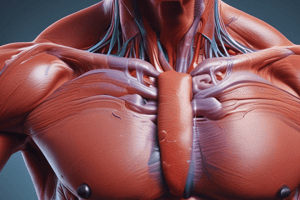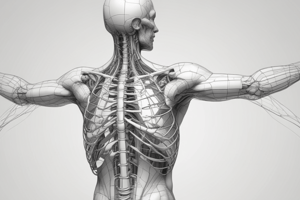Podcast
Questions and Answers
What is the first step in the inspection of the lower extremities?
What is the first step in the inspection of the lower extremities?
- Checking for bruising
- Observing muscle wasting
- Examining the hip
- Assessing the patient's gait (correct)
Which of the following is NOT a part of the lower extremity inspection?
Which of the following is NOT a part of the lower extremity inspection?
- Evaluating muscle strength (correct)
- Looking for swelling
- Checking for calluses
- Noting skin color and texture
What is one of the findings that should be verbalized during inspection of the lower extremities?
What is one of the findings that should be verbalized during inspection of the lower extremities?
- Identifying muscle strength abnormalities
- Noting the presence of pigmentation (correct)
- Detecting enlarged veins
- Not seeing any joint concavities
During lower extremity palpation, what should be checked near the patella?
During lower extremity palpation, what should be checked near the patella?
What is one crucial aspect to assess when examining the lower extremities' alignment?
What is one crucial aspect to assess when examining the lower extremities' alignment?
Which of the following is a key element to evaluate when inspecting the hip?
Which of the following is a key element to evaluate when inspecting the hip?
What percentage of the walking cycle is considered the Swing phase?
What percentage of the walking cycle is considered the Swing phase?
Which muscle group contracts to stabilize the pelvis during the gait cycle?
Which muscle group contracts to stabilize the pelvis during the gait cycle?
What gait abnormality may result from lack of knee flexion during the stance phase?
What gait abnormality may result from lack of knee flexion during the stance phase?
What does a wide base suggest during a gait inspection?
What does a wide base suggest during a gait inspection?
What condition can cause the pelvis to drop on the opposite side during gait?
What condition can cause the pelvis to drop on the opposite side during gait?
What should be assessed for symmetry when inspecting the legs in a supine patient?
What should be assessed for symmetry when inspecting the legs in a supine patient?
How is muscle strength graded on a 0 to 5 scale?
How is muscle strength graded on a 0 to 5 scale?
Which joint is primarily involved in ankle inversion and eversion?
Which joint is primarily involved in ankle inversion and eversion?
In strength testing, what does a grade of '2' mean?
In strength testing, what does a grade of '2' mean?
Which muscle group is primarily responsible for hip flexion?
Which muscle group is primarily responsible for hip flexion?
What action should be performed to test hip flexion?
What action should be performed to test hip flexion?
During strength testing, what does a grade of '4' indicate?
During strength testing, what does a grade of '4' indicate?
Where should you look for pitting edema on the feet?
Where should you look for pitting edema on the feet?
What is the severity of edema graded on?
What is the severity of edema graded on?
Which of the following is NOT a motion of the hip?
Which of the following is NOT a motion of the hip?
How should you test the range of motion for hip flexion?
How should you test the range of motion for hip flexion?
How can you stabilize the pelvis during hip abduction?
How can you stabilize the pelvis during hip abduction?
What does the movement of the iliac spine mark during hip abduction?
What does the movement of the iliac spine mark during hip abduction?
What is the recommended technique for palpating the femoral pulse?
What is the recommended technique for palpating the femoral pulse?
What is the typical size of nontender, discrete inguinal nodes in normal people?
What is the typical size of nontender, discrete inguinal nodes in normal people?
Where is the recommended location for palpating the DP pulse?
Where is the recommended location for palpating the DP pulse?
What is the difficulty level of finding the popliteal pulse compared to other pulses?
What is the difficulty level of finding the popliteal pulse compared to other pulses?
What is the recommended technique for palpating for pitting edema?
What is the recommended technique for palpating for pitting edema?
Where is the recommended location for palpating the PT pulse?
Where is the recommended location for palpating the PT pulse?
Flashcards are hidden until you start studying




